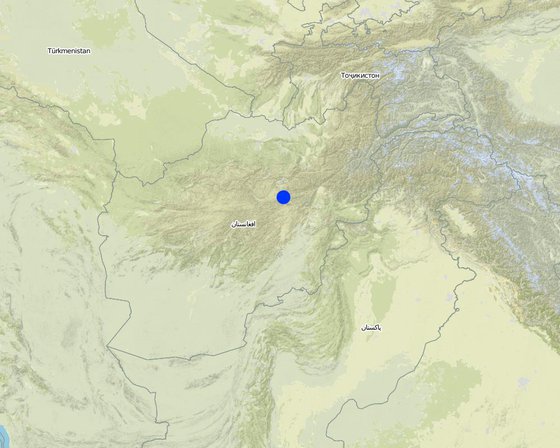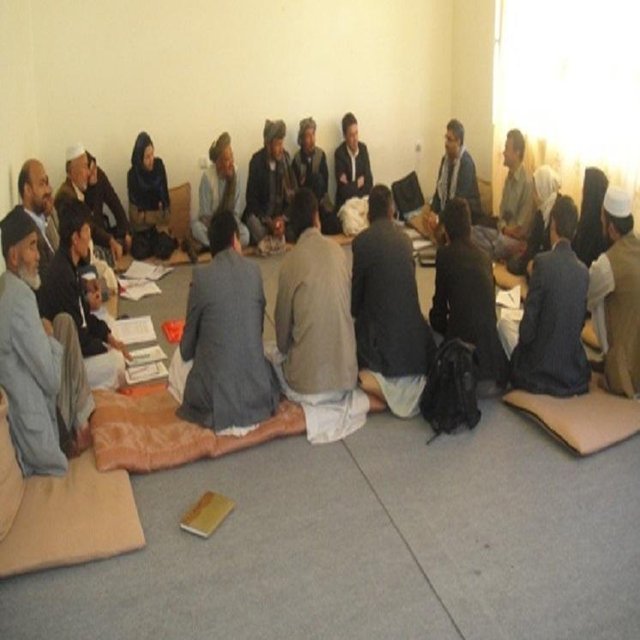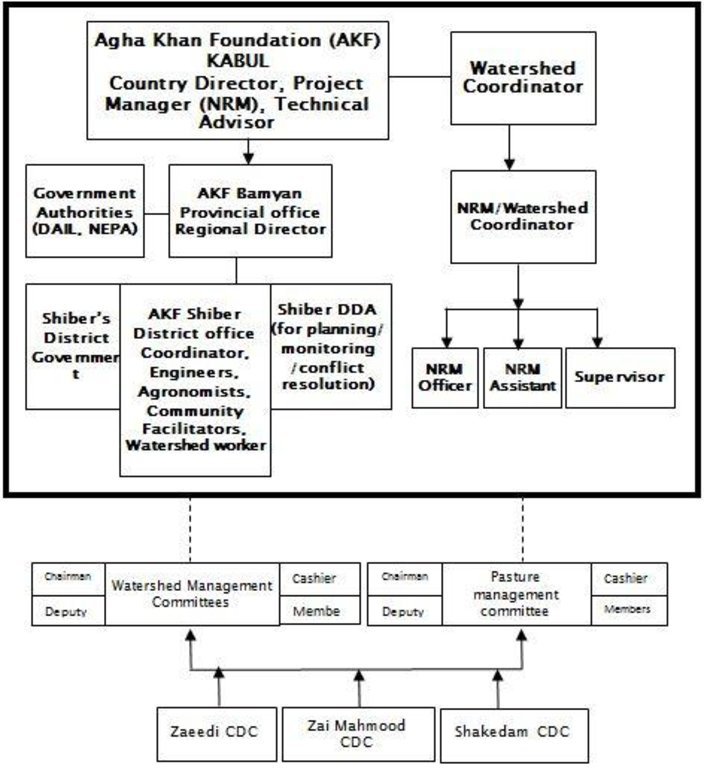Community-based Natural Resource Management
(ອັຟການີດສະຖານ)
Tanzeem Manabae Tabiee Tawasut Mardum (Dari)
ຄຳອະທິບາຍ
An approach to community participation in the sustainable management of natural resources
The main objective of the intervention was to reduce the surface run-off and sediment flow from the selected degraded watershed, with soil and water conservation measures through community participation.
Agha Khan Foundation and representatives from the selected Community Development Councils (CDC) surveyed the area and discussed the main land use problems. On the basis of feasibility surveys, potential SLM technologies were identified and implemented. Contour lines were prepared with the help of an A-frame and lime. Several men from Zai Mahmood village were employed as daily wage workers for the technology implementation works. The land users used their own tools for trench excavation. Each worker excavated on an average one trench per day. The daily wage was 250 AFS/USD.
The project was executed over two years. In addition to the structural measures, training and exposure visits for watershed management committee and pasture committee members, reseeding of more areas, tree plantation campaigns and group-based women vegetable farming were realized. Women were employed for seed collection work with cash for work approach. The area was protected from grazing and shrub cutting pressure. Seeds of different fodder varieties and shrubs were also cultivated.
Since the realization of the project in 2008, soil and vegetation cover has improved, people’s knowledge about soil and water conservation has increased, flash floods have been controlled and discharge in the spring located below the watershed has increased by about 40%. AKF continues to support the target communities with community development and institution building. The water-shed work is sustained by a watershed and pasture management committee appointed by the people from three respective CDCs.
The Community-Based Natural Resource Management approach is documented by Sustainable Land Management Project implemented/HELVETAS Swiss Intercooperation which is funded by Swiss Agency for Development and Cooperation with close support and cooperation of the Agha Khan Foundation (AKF).
The watershed project was funded by AusAID. The Aga Khan Foundation (AKF) facilitated the implementation by the community. The project was implemented in Zai Mahmood mountain slope area in Zai Mahmood village, Shiber district, Bamyan Province. The village, located downstream from the site, experienced problems such as excessive surface runoff/flash floods, snow avalanches, soil erosion, lack of drinking water, lack of soil moisture at the site.
ສະຖານທີ່

ສະຖານທີ່: Bamyan center, Afghanistan, Zai Mahmood village, ອັຟການີດສະຖານ
ການຄັດເລືອກພື້ນທີ່ ທີ່ອີງໃສ່ຂໍ້ມູນທາງພູມີສາດ
ວັນທີເລີ່ມຕົ້ນ: 2008
ປີຂອງການສິ້ນສຸດ: n.a.
ປະເພດຂອງແນວທາງ
-
ພື້ນເມືອງ / ທ້ອງຖີ່ນ
-
ການລິເລີ່ມ ພາຍໃນປະເທດ ທີ່ຜ່ານມາ / ນະວັດຕະກໍາ
-
ພາຍໃຕ້ໂຄງການ / ແຜນງານ

Evaluation of the approach by WOCAT training participants with the help of land users (Madhav Dhakal)
ເປົ້າໝາຍຂອງແນວທາງ ແລະ ການປົກປັກຮັກສາສິ່ງແວດລ້ອມ
ເປົ້າໝາຍ / ຈຸດປະສົງຫຼັກໃນການຈັດຕັ້ງປະຕິບັດແນວທາງ
The Approach focused mainly on SLM with other activities (Disaster Risk Reduction, Pasture Improvement, Gender Equity, Income Generation)
Strengthen the capacity (organizational and technical), of the community to: restore their degraded lands, demonstrate multi-purpose soil and water conservation measures, reduce floods and snow avalanches, improve pastures, improve gender equity and the involvement of social disadvantaged groups, employment and income generation
The SLM Approach addressed the following problems: Lack of knowledge in terms of sustainable watershed management; poverty; drought; floods and avalanches
ເງື່ອນໄຂທີ່ສະໜັບສະໜູນໃຫ້ການຈັດຕັ້ງປະຕິບັດເຕັກໂນໂລຢີ ບົນພື້ນຖານແນວທາງ
ເງື່ອນໄຂທີ່ເຊື່ອງຊ້ອນໃຫ້ການຈັດຕັ້ງປະຕິບັດເຕັກໂນໂລຢີ ບົນພື້ນຖານແນວທາງ
-
ສັງຄົມ / ວັດທະນະທໍາ / ມາດຕະຖານ ແລະ ຄຸນຄ່າທາງສາສະໜາ: Community-based management capacity was weak
Treatment through the SLM Approach: CDCs capacities were enhanced
-
ມີຄວາມສາມາດ / ເຂັ້າເຖິງຊັບພະຍາກອນດ້ານການເງິນ ແລະ ການບໍລິການ: Community’s low economy
Treatment through the SLM Approach: AKF provided financial support; also there were contributions from the participating community
-
ການກໍ່ຕັ້ງສະຖາບັນ: Lack of organizational structures
Treatment through the SLM Approach: Watershed and pasture management committees formed
-
ຄວາມຮູ້ກ່ຽວກັບການຄຸ້ມຄອງ ທີ່ດິນແບບຍືນຍົງ, ການເຂົ້າເຖິງການສະໜັບສະໜູນ ທາງດ້ານວິຊາການ: Lack of technical awareness
Treatment through the SLM Approach: AKF provided technical support
ການມີສ່ວນຮ່ວມ ແລະ ບົດບາດຂອງພາກສ່ວນທີ່ກ່ຽວຂ້ອງທີ່ມີສ່ວນຮ່ວມ
ພາລະບົດບາດຂອງພາກສ່ວນທີ່ກ່ຽວຂ້ອງ ທີ່ມີສ່ວນຮ່ວມໃນການຈັດຕັ້ງປະຕິບັດແນວທາງ
| ແມ່ນໃຜ / ພາກສ່ວນໃດ ທີ່ເປັນເຈົ້າການ ໃນການຈັດຕັ້ງປະຕິບັດ ວິທີການ? |
ລະບຸ ພາກສ່ວນທີ່ກ່ຽວຂ້ອງ |
ພັນລະນາ ບົດບາດ ໜ້າທີ່ ຂອງພາກສ່ວນທີ່ກ່ຽວຂ້ອງ |
| ຜູ້ນໍາໃຊ້ດິນໃນທ້ອງຖິ່ນ / ຊຸມຊົນທ້ອງຖິ່ນ |
|
|
| ອົງການຈັດຕັ້ງ ພາຍໃນຊຸມຊົນ |
|
|
ການລວບລວມເອົາຜູ້ນໍາໃຊ້ທີ່ດິນໃນທ້ອງຖິ່ນ/ຊຸມຊົນທ້ອງຖິ່ນ ໃນການຈັດຕັ້ງປະຕິບັດແນວທາງ ແຕ່ລະໄລຍະ
ບໍ່ມີ
ການບໍ່ປະຕິບັດ
ການຊ່ວຍເຫຼືອຈາກພາຍນອກ
ການຮ່ວມມື
ການນໍາໃໍຊ້ເອງ
ການເລີ່ມຕົ້ນ / ແຮງຈູງໃຈ
Meetings and Workshops for men and women
ການວາງແຜນ
With CDC members, mainly men for watershed works
ການປະຕິບັດ
Interactive, Cash for work, Contributions from communities as well
ຕິດຕາມກວດກາ / ການປະເມີນຜົນ
Research
Analyzing technology performance and making adjustments if required
ແຜ່ນວາດສະແດງ
The organization structure of the NRM project implemented in Zai Mahmood village, Shiber district, Bamyan, Afganistan

ຜູ້ຂຽນ: Agha Khan Foundation (AKF)
ການຕັດສິນໃຈໃນການເລືອກເຕັກໂນໂລຢີ ການຄຸ້ມຄອງທີ່ດິນແບບຍືນຍົງ
ການຕັດສິນໃຈໂດຍ
-
ຜູ້ນໍາໃຊ້ດິນຜູ້ດຽວ (ການລິເລີ່ມດ້ວຍຕົນເອງ)
-
ຜູ້ນໍາໃຊ້ທີ່ດິນຫຼັກ, ການສະໜັບສະໜູນ ໂດຍຜູ້ຊ່ຽວຊານ ການນໍາໃຊ້ທີ່ດິນແບບຍືນຍົງ
-
ພາກສ່ວນກ່ຽວຂ້ອງທັງໝົດ, ເປັນສ່ວນໜຶ່ງ ຂອງວິທີທາງແບບມີສ່ວນຮ່ວມ
-
ຜູ້ຊ່ຽວຊານ ຫຼັກດ້ານການຄຸ້ມຄອງ ທີ່ດິນແບບຍືນຍົງ, ມີການຕິດຕາມປຶກສາຫາລືກັບຜູ້ນໍາໃຊ້ທີ່ດິນ
-
ຊຽ່ວຊານ ສະເພາະດ້ານການຄຸ້ມຄອງ ດິນແບບຍືນຍົງຜູ້ດຽວ
-
ນັກການເມືອງ / ຜູ້ນໍາ
ການຕັດສິນໃຈບົນພື້ນຖານ
-
ປະເມີນເອກກະສານ ຄວາມຮູ້ກ່ຽວກັບ ການຄຸ້ມຄອງ ທີ່ດິນແບບຍືນຍົງ (ຫຼັກຖານທີ່ຊ່ວຍໃນການຕັດສິນໃຈ)
-
ຜົນທີ່ໄດ້ຮັບ ຈາກການຄົ້ນຄວ້າ
-
ປະສົບການສ່ວນບຸກຄົນ ແລະ ຄວາມຄິດເຫັນ (ທີ່ບໍ່ເປັນເອກກະສານ)
ການສະໜັບສະໜູນເຕັກໂນໂລຢີ, ການສ້າງຄວາມອາດສາມາດ ແລະ ການຄຸ້ມຄອງຄວາມຮູ້
ກິດຈະກຳ ດັ່ງລຸ່ມນີ້ ແມ່ນເປັນພາກໜຶ່ງຂອງແນວທາງ
-
ການສ້າງຄວາມສາມາດ / ການຝຶກອົບຮົມ
-
ການບໍລິການໃຫ້ຄໍາປຶກສາ
-
ສະຖາບັນການສ້າງຄວາມເຂັ້ມແຂງ (ການພັດທະນາອົງການຈັດຕັ້ງ)
-
ຕິດຕາມກວດກາ ແລະ ປະເມີນຜົນ
-
ການຄົ້ນຄວ້າ
ການສ້າງຄວາມອາດສາມາດ / ຝຶກອົບຮົມ
ໄດ້ສະໜັບສະໜູນຝຶກອົບຮົມໃຫ້ແກ່ພາກສ່ວນກ່ຽວຂ້ອງດັ່ງລຸ່ມນີ້
-
ຜູ້ນໍາໃຊ້ດິນ
-
ພະນັກງານພາກສະໜາມ / ທີ່ປຶກສາ
ຮູບແບບການຝຶກອົບຮົມ
-
ການເຮັດຕົວຈິງ
-
ຕົວຕໍ່ຕົວ
-
ເນື້ອທີ່ສວນທົດລອງ
-
ກອງປະຊຸມ
-
ຫຼັກສູດ
ກວມເອົາຫົວຂໍ້
Vegetable farming for women; soil and water conservation; watershed management; pasture management. Training was mainly on-the-job, and awareness was raised through public meetings, site visits and demonstrations.
ການບໍລິການທາງດ້ານການໃຫ້ຄໍາປຶກສາ
ໄດ້ຮັບການບໍລິການທາງດ້ານການໃຫ້ຄໍາປຶກສາ
-
ໃນພື້ນທີ່ຂອງຜູ້ນໍາໃຊ້ດິນ
-
ສູນຄົ້ນຄວ້າ
On-site visits by DAIL (Department of Agriculture, Irrigation and Livestock; Key elements: Pasture management, Site selection
Advisory service is quite adequate to ensure the continuation of land conservation activities; The government or other advisory service is quite adequate to ensure the continuation of land conservation activities although the staff turnover rate in government sector is high. DAIL Bamyan office has the technical capacity but not adequate financial resources.
ຄວາມເຂັ້ມແຂງຂອງສະຖາບັນ
ສະຖາບັນ ໄດ້ຮັບການສ້າງຄວາມເຂັ້ມແຂງ
-
ບໍ່ມີ
-
ມີ, ໜ້ອຍໜຶ່ງ
-
ມີ, ພໍສົມຄວນ
-
ມີ, ຫຼາຍ
ໃນລະດັບດັ່ງລຸ່ມນີ້
-
ທ້ອງຖິ່ນ
-
ລະດັບພາກພື້ນ
-
ແຫ່ງຊາດ
ອະທິບາຍສະຖາບັນ, ພາລະບົດບາດແລະຄວາມຮັບຜິດຊອບ, ສະມາຊິກ, ແລະອື່ນໆ.
ຮູບແບບການສະໜັບສະໜູນ
-
ທາງດ້ານການເງິນ
-
ການສ້າງຄວາມອາດສາມາດ / ການຝຶກອົບຮົມ
-
ອຸປະກອນ
ລາຍລະອຽດເພີ່ມເຕີມ
CDCs and District Development Assembly (DDA) in terms of financial and capacity building of participating
ການຕິດຕາມ ແລະ ປະເມີນຜົນ
bio-physical aspects were regular monitored by project staff, land users through measurements; indicators: Biomass before and after
technical aspects were ad hoc monitored by project staff, land users through observations; indicators: growth of saplings, shrubs and fodder grasses (alfalfa)
socio-cultural aspects were ad hoc monitored by project staff, land users through measurements; indicators: Water availablity, food security, income
economic / production aspects were regular monitored by project staff through measurements; indicators: fodder production, income
area treated aspects were ad hoc monitored by project staff through measurements; indicators: areas where technology was applied
no. of land users involved aspects were regular monitored by project staff, land users through measurements; indicators: CDCs and men and women involved
management of Approach aspects were regular monitored by project staff, government, land users through observations; indicators: area protected or not
There were few changes in the Approach as a result of monitoring and evaluation: Women has given some more chances for the participation but still there is long way to go. There were some technology refinements and adjustments in project management.
ການຄົ້ນຄວ້າ
ການວິໄຈໄດ້ຮັບການຮັກສາຫົວຂໍ້ຕໍ່ໄປນີ້
-
ສັງຄົມ
-
ເສດຖະສາດ / ການຕະຫຼາດ
-
ລະບົບນິເວດ
-
ເຕັກໂນໂລຢີ
However there are no publications to verify that. Research was carried out on-farm
ການສະໜັບສະໜູນທາງດ້ານການເງິນ ແລະ ອຸປະກອນຈາກພາຍນອກ
ງົບປະມານປະຈຳປີ ໃນກິດຈະກຳ ການຄຸ້ມຄອງທີ່ດິນແບບຍືນຍົງ ທີ່ເປັນສະກຸນເງິນໂດລາ
-
< 2,000
-
2,000-10,000
-
10,000-100,000
-
100,000-1,000,000
-
> 1,000,000
Precise annual budget: n.a.
Approach costs were met by the following donors: international: 50.0%; national non-government: 30.0%; local community / land user(s): 20.0%
ການບໍລິການ ຫຼື ສິ່ງກະຕຸກຊຸກຍູ້ ດັ່ງລຸ່ມນີ້ ແມ່ນໄດ້ສະໜອງໂດຍຜູ້ນຳໃຊ້ທີ່ດິນເອງ
-
ການສະໜັບສະໜູນ ທາງດ້ານການເງິນ / ອຸປະກອນ ສະໜອງໃຫ້ແກ່ຜູ້ນໍາທີ່ດິນ
-
ຫຼຸດປັດໃຈນໍາເຂົ້າ
-
ສິນເຊື່ອ
-
ສິ່ງຈູງໃຈ ຫຼື ເຄື່ອງມືອື່ນໆ
ການວິເຄາະຜົນກະທົບ ແລະ ສະຫຼຸບລວມ
ຜົນກະທົບຂອງການນໍາໃຊ້ແນວທາງ
ບໍ່
ມີ, ໜ້ອຍໜຶ່ງ
ມີ, ພໍສົມຄວນ
ມີ, ຫຼາຍ
ການຈັດຕັ້ງປະຕິບັດ ວິທີທາງ ສາມາດຊ່ວຍຜູ້ນໍາໃຊ້ທີ່ດິນ ໃນການຈັດຕັ້ງປະຕິບັດ ແລະ ບໍາລຸງຮັກສາ ເຕັກໂນໂລຢີ ການຄຸ້ມຄອງ ທີ່ດິນແບບຍືນຍົງໄດ້ບໍ?
Increased water and soil quality with more vegetation and reduction in floods
ການຈັດຕັ້ງປະຕິບັດ ວິທີທາງ ສາມາດສ້າງຄວາມເຂັ້ມແຂງ ທາງສັງຄົມ ແລະ ເສດຖະກິດບໍ່?
Through increased decision-making powers about natural resources by poor and marginalized members of the community.
Did other land users / projects adopt the Approach?
There is no spontaneous adoption.
ສິ່ງກະຕຸກຊຸກຍູ້ໃຫ້ຜູ້ນໍາໃຊ້ທີ່ດິນ ໃນການປະຕິບັດການຄຸ້ມຄອງທີ່ດິນແບບຍືນຍົງ
-
Reduced flash floods & improved land productivity
ຄວາມຍືນຍົງຂອງການຈັດຕັ້ງປະຕິບັດກິດຈະກໍາຂອງແນວທາງ
ຜູ້ນໍາໃຊ້ທີ່ດິນ ສາມາດຈັດຕັ້ງປະຕິບັດຕາມແນວທາງໄດ້ເອງບໍ່ (ໂດຍປາດສະຈາກການສະໜັບສະໜູນຈາກພາກສ່ວນພາຍນອກ)?
ບົດສະຫຼຸບ ແລະ ບົດຮຽນທີ່ໄດ້ຮັບ
ຄວາມເຂັ້ມແຂງ: ທັດສະນະມູມມອງ ຂອງຜູ້ນໍາໃຊ້ທີ່ດິນ
ຄວາມເຂັ້ມແຂງ: ທັດສະນະມຸມມອງ ຂອງຜູ້ປ້ອນຂໍ້ມູນເອງ
-
Increase in vegetation cover
-
People knowledge regarding SWC improved
-
Increase in spring water
-
Flash flood controlled
-
Watershed and pasture management committees formed
ຈຸດອ່ອນ / ຂໍ້ເສຍ / ຄວາມສ່ຽງ: ທັດສະນະມູມມອງ ຂອງຜູ້ນໍາໃຊ້ທີ່ດິນວິທີການແກ້ໄຂແນວໃດ
ຈຸດອ່ອນ / ຂໍ້ເສຍ / ຄວາມສ່ຽງ: ທັດສະນະມຸມມອງ ຂອງຜູ້ປ້ອນຂໍ້ມູນເອງວິທີການແກ້ໄຂແນວໃດ
-
Disturbance in NRM / soil disturbance
Minimize the soil disturbance, and compact the excavated soil
-
Increase in mice
Compact the excavated soil, other control measures
-
Plant growth is slow due to high elevation
Choose adaptable species
-
No watershed benefit sharing mechanism in place
Benefit mechanism be developed in a participatory way and agreed by the land users and other stakeholders
ເອກກະສານອ້າງອີງ
ການທົບທວນຄືນ
-
Deborah Niggli
-
Joana Eichenberger
ວັນທີຂອງການປະຕິບັດ: Feb. 9, 2016
ປັບປຸງລ່າສຸດ: April 18, 2019
ບຸກຄົນທີ່ສໍາຄັນ
-
Helaluddin Musadiq (helal.musadiq@slmi.org.af) - ຜູ້ຊ່ຽວຊານ ດ້ານການຄຸ້ມຄອງ ທີ່ດິນແບບຍືນຍົງ
-
Sanjeev Bhuchar (sanjeev.bhuchar@helvetas.org) - ຜູ້ຊ່ຽວຊານ ດ້ານການຄຸ້ມຄອງ ທີ່ດິນແບບຍືນຍົງ
-
Madhav Dhakal (mdhakal@icimod.org) - ຜູ້ຊ່ຽວຊານ ດ້ານການຄຸ້ມຄອງ ທີ່ດິນແບບຍືນຍົງ
-
Ghulam Sakhi Ahmadi - ຜູ້ຊ່ຽວຊານ ດ້ານການຄຸ້ມຄອງ ທີ່ດິນແບບຍືນຍົງ
-
M. Altaf Jalil - ຜູ້ຊ່ຽວຊານ ດ້ານການຄຸ້ມຄອງ ທີ່ດິນແບບຍືນຍົງ
-
Marzia Hussaini - ຜູ້ຊ່ຽວຊານ ດ້ານການຄຸ້ມຄອງ ທີ່ດິນແບບຍືນຍົງ
-
Baqir Hussaini - ຜູ້ຊ່ຽວຊານ ດ້ານການຄຸ້ມຄອງ ທີ່ດິນແບບຍືນຍົງ
-
Jawad Wafa - ຜູ້ຊ່ຽວຊານ ດ້ານການຄຸ້ມຄອງ ທີ່ດິນແບບຍືນຍົງ
-
Asadullah Jawadi - ຜູ້ຊ່ຽວຊານ ດ້ານການຄຸ້ມຄອງ ທີ່ດິນແບບຍືນຍົງ
-
Alex Yagoo - ຜູ້ຊ່ຽວຊານ ດ້ານການຄຸ້ມຄອງ ທີ່ດິນແບບຍືນຍົງ
-
Muhammad Eqbal - ຜູ້ຊ່ຽວຊານ ດ້ານການຄຸ້ມຄອງ ທີ່ດິນແບບຍືນຍົງ
ການບັນຍາຍລາຍລະອຽດ ໃນຖານຂໍ້ມູນ ຂອງ WOCAT
ຂໍ້ມູນການເຊື່ອມໂຍງຂໍ້ມູນການຄຸ້ມຄອງການນໍາໃຊ້ດິນແບບຍືນຍົງ
ເອກກະສານ ແມ່ນໄດ້ອໍານວຍຄວາມສະດວກໂດຍ
ສະຖາບັນ
- HELVETAS (Swiss Intercooperation)
ໂຄງການ




